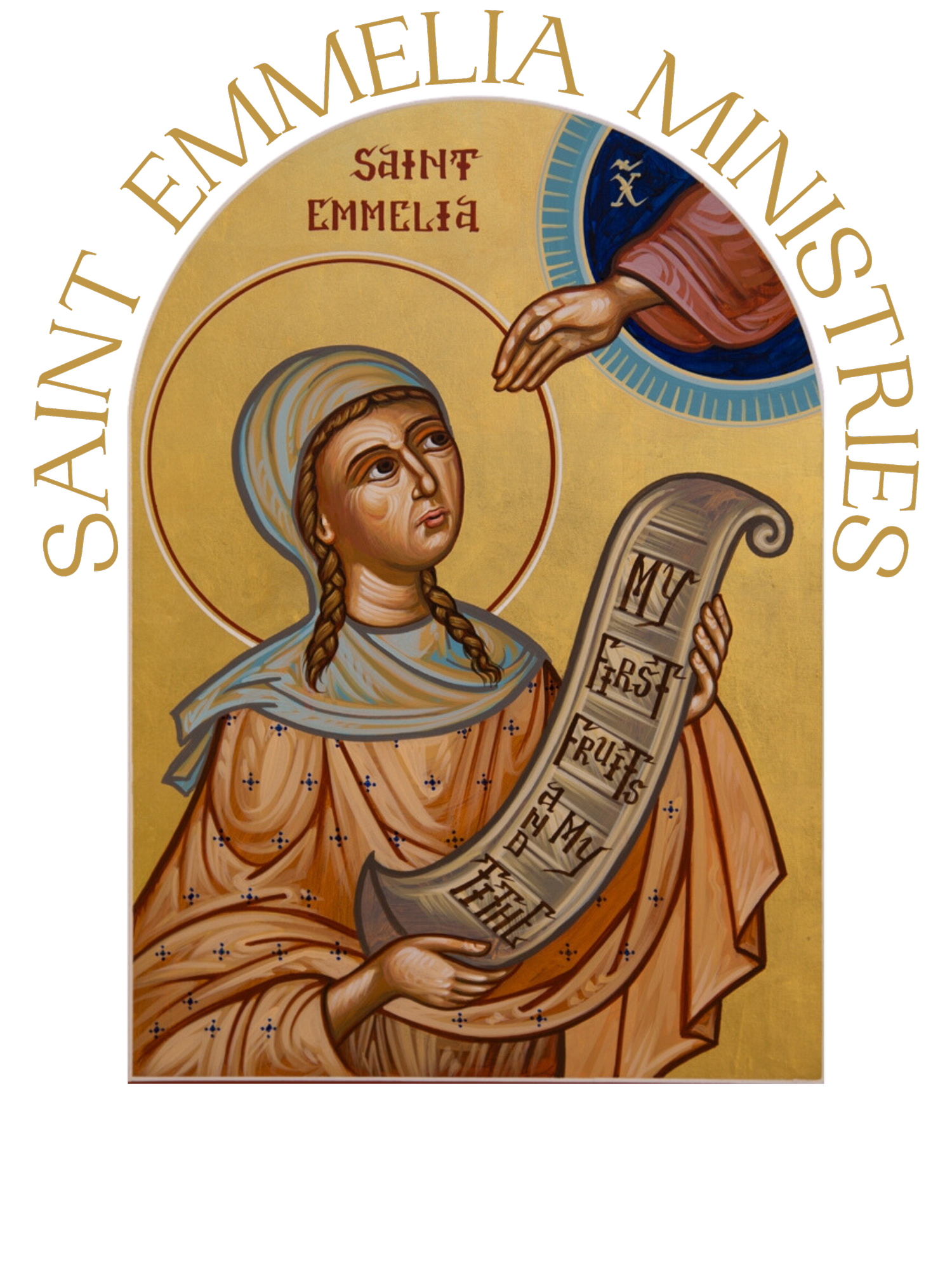by Mindi Popovich-Schneider, Saint Emmelia Ministries Assistant
Something you might not know about me (or maybe you already do know this, and you’re about to be like, “please, Mindi, enough already!”) is that I used to be a Children’s Librarian. One major aspect of my job was planning storytimes, which meant thinking a lot about pre-literacy skills and teaching parents how to help their children hone these skills. So today, I’m going to talk about the six areas of early literacy and ways that you can strengthen your child’s skills in these areas, specifically by engaging with our Faith!
The first area is vocabulary. Children ages newborn to four should hear between 17,000-21,000 words per day. Research shows that children who hear substantially fewer words than this tend to struggle in the first few years of school. Now, since we’re all hanging out on the Saint Emmelia Ministries website, I would hazard a guess that not a lot of us put much stock into public education’s metrics for success. Still, I think the message is clear: words matter! Reading (naturally!), narrating what you’re doing, and asking open-ended questions and modeling a response–all these things can increase the number of words your child hears per day.
Fortunately, being Orthodox puts us at an advantage: take your child to any service, and they will hear between 25% and 40% of those words. Add in morning, evening, and mealtime prayers, and you’re zooming towards that goal! On top of all of that, you’re automatically introducing them to lovely, delightful words that most kids don’t have the opportunity to encounter.
Singing is incredibly important for developing literacy skills. When we sing, we draw out our syllables naturally. Children then can hear the individual sounds and understand that words are broken up into smaller parts. This understanding is called “phonological awareness,” which later helps children sound out words while reading.
Here again, because music is such an important part of our faith, Orthodoxy comes in handy! Sing hymns with your kids throughout the day, and they’ll DEFINITELY be hearing all those phonemes (“aaaaaaaaa-leeeeeeeeee-luuuuuuuuuu-iaaaaaaaa”)!When you’re out and about–talking walks, going to the grocery store, etc.–you probably talk to your little ones about what you see (personally, puppy doggies and “cycs”–motorcycles–are a BIG topic of discussion any time we leave the house!). Do you ever pause and talk to your kids about signs or logos? Well, that is one incredibly easy way to help develop print awareness, the understanding that letters and numbers have meaning. When reading books with your children, point out specific words, especially if those words are in a font that stands out from the others. Books with very few words are also great for developing this skill because it makes it easier for kids to connect an isolated symbol with its meaning.
When you’re looking at icons, be sure to point out the writing. Explain that the writing is the saint’s name. Show them the text on the scrolls and explain that it’s something that particular saint said.
Move over, geometry: shapes are important for reading too! After all, what are letters but shapes combined in different ways? Shape-sorting games are a great foundation for learning to write letters. As you play, talk about the similarities and differences in shapes. When you’re out and about, identify the different shapes you see. All of this helps build letter knowledge, the ability to distinguish between and identify letters.
Thank goodness that Orthodoxy is so tactile! As you look at all the objects around you in your home or at church, talk about the shapes they are made up of. Use your child’s fingers to trace the length of a candle or the roundness of the antidoron.
If your family is anything like mine, you’ve probably had to read one or two books over and over and over and over. While you might be reciting Goodnight, Moon in your sleep, this repetition is actually incredibly important for kids because it strengthens their narrative skills, or the ability to understand stories. When a child hears a story over and over, they begin to recall what happens next, unconsciously absorbing an ordered sequence of events.
Playing pretend–even something as basic as pretending that a blanket is a priest’s robe–can help strengthen narrative skills because it helps kids think symbolically. Playing “Liturgy” can also help kids strengthen their understanding of sequence. As your kids gain more speech, have them narrate to you what you’re doing as you prepare to say prayers (or as you watch liturgy from the Narthex!)
The best literacy area (in my opinion) is print motivation, or a child’s interest in and enjoyment of books. For very young children, this means allowing them to explore books in their own way: going backwards and forwards as they wish, lingering over pictures, skipping pages or reading them over and over, and even chewing on pages! At any age, being snuggled up together creates an association between reading and feeling loved.
Reading books about Orthodoxy can be motivating because they have an immediate connection to your child’s life. When kids recognize something in a book–perhaps a priest’s robe or a specific icon–they are more likely to want to engage with the book and find out what is going on in the pictures.
One of my biggest takeaways from my time in libraries is that almost everything we do contributes to early literacy in one way or another. You can make these activities extra rich by engaging with your kids through questions and making connections to the six different areas of literacy. And of course, as with everything in life, the best place for growth is in the beauty and love of the Church!

